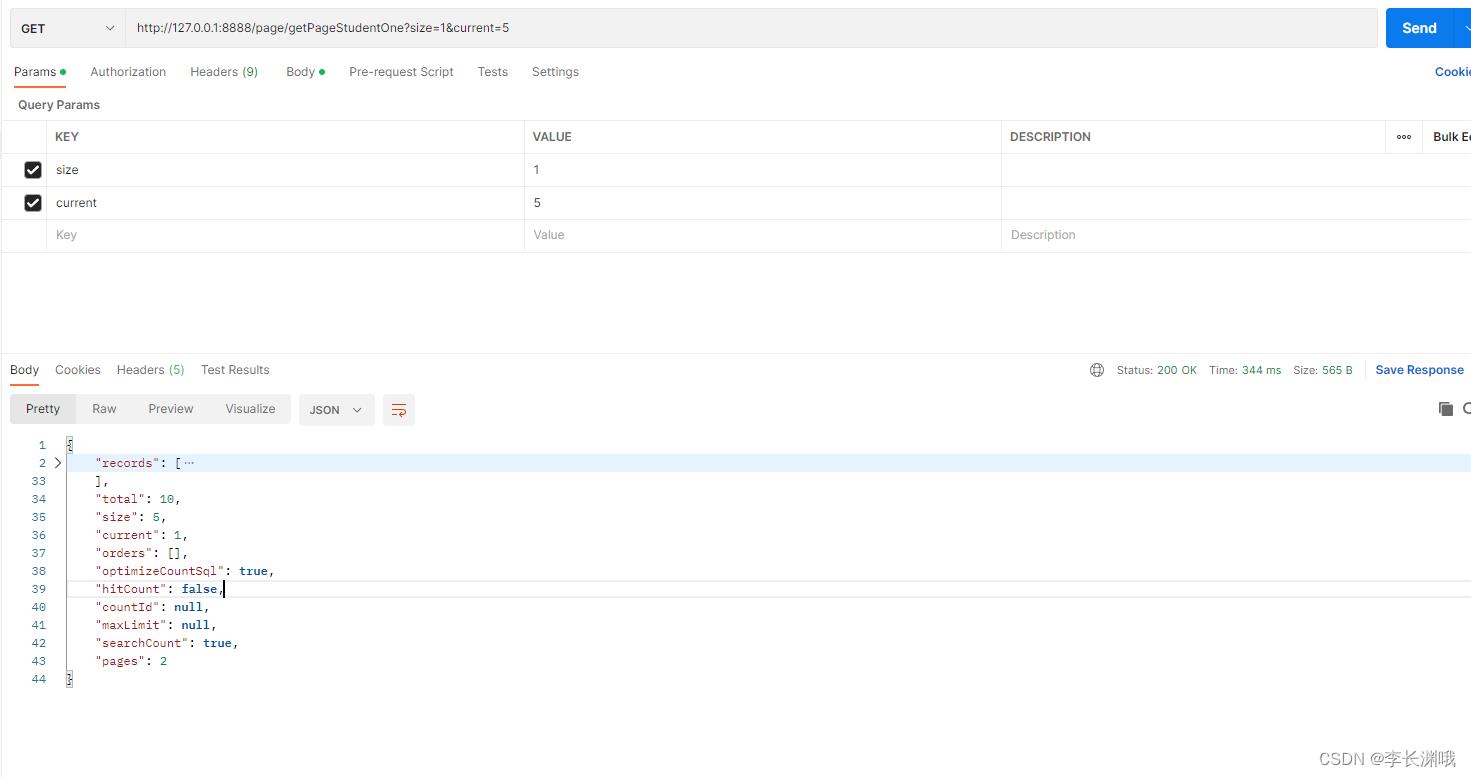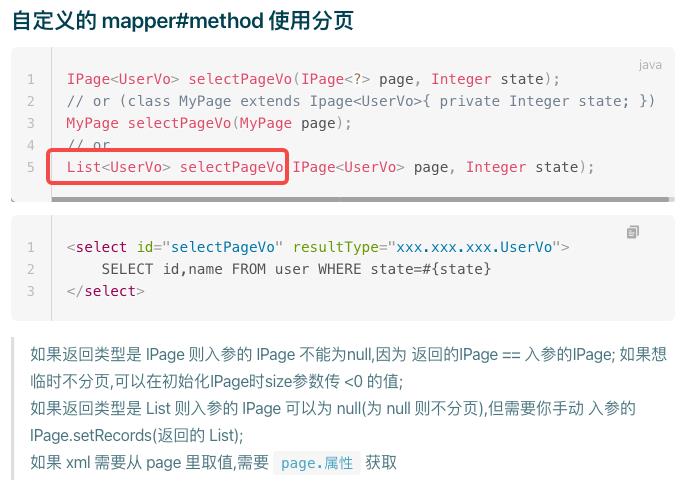mybatis-plus分页查询三种方法
Posted 李长渊哦
tags:
篇首语:本文由小常识网(cha138.com)小编为大家整理,主要介绍了mybatis-plus分页查询三种方法相关的知识,希望对你有一定的参考价值。
mybatis-plus分页查询
一、前期准备表
CREATE TABLE `school_student` (
`id` int(11) NOT NULL AUTO_INCREMENT,
`name` varchar(255) DEFAULT NULL,
`sex` varchar(255) DEFAULT NULL,
`age` int(11) DEFAULT NULL,
PRIMARY KEY (`id`)
) ENGINE=InnoDB AUTO_INCREMENT=11 DEFAULT CHARSET=utf8;
INSERT INTO `avlicy`.`school_student`(`id`, `name`, `sex`, `age`) VALUES (1, 'av峰峰', '男', 1);
INSERT INTO `avlicy`.`school_student`(`id`, `name`, `sex`, `age`) VALUES (2, '卢本伟', '男', 12);
INSERT INTO `avlicy`.`school_student`(`id`, `name`, `sex`, `age`) VALUES (3, '小米粥', '女', 13);
INSERT INTO `avlicy`.`school_student`(`id`, `name`, `sex`, `age`) VALUES (4, '黄米粥', '女', 15);
INSERT INTO `avlicy`.`school_student`(`id`, `name`, `sex`, `age`) VALUES (5, '蓝米粥', '女', 11);
INSERT INTO `avlicy`.`school_student`(`id`, `name`, `sex`, `age`) VALUES (6, '白米粥', '女', 17);
INSERT INTO `avlicy`.`school_student`(`id`, `name`, `sex`, `age`) VALUES (7, '红米粥', '女', 15);
INSERT INTO `avlicy`.`school_student`(`id`, `name`, `sex`, `age`) VALUES (8, '橙米粥', '女', 16);
INSERT INTO `avlicy`.`school_student`(`id`, `name`, `sex`, `age`) VALUES (9, '青米粥', '女', 13);
INSERT INTO `avlicy`.`school_student`(`id`, `name`, `sex`, `age`) VALUES (10, '紫米粥', '女', 12);
1、配置类
@Configuration
//@MapperScan("com.example.demo.mapper")
public class MybatisPlusConfig
/**
* 新增分页拦截器,并设置数据库类型为mysql
* @return
*/
@Bean
public MybatisPlusInterceptor mybatisPlusInterceptor()
MybatisPlusInterceptor interceptor = new MybatisPlusInterceptor();
interceptor.addInnerInterceptor(new PaginationInnerInterceptor(DbType.MYSQL));
return interceptor;
二、使用selectPage
1、Service
//分页参数
Page<SchoolStudent> rowPage = new Page(page, pageSize);
//queryWrapper组装查询where条件
LambdaQueryWrapper<SchoolStudent> queryWrapper = new LambdaQueryWrapper<>();
rowPage = this.baseMapper.selectPage(rowPage, queryWrapper);
return rowPage;
2、结果


三、使用2种分页查询的写法
1、xml
<select id="getPageStudentTwo" resultType="com.example.demo.entity.base.SchoolStudent">
select * from school_student
</select>
2、Mapper
说明:
1、mybatis-plus中分页接口需要包含一个IPage类型的参数。
2、多个实体参数,需要添加@Param参数注解,方便在xml中配置sql时获取参数值。
注意这里我虽然加了@Param但是我并没有使用
Page<SchoolStudent> getPageStudentTwo(Page<SchoolStudent> rowPage,@Param("schoolStudent") SchoolStudent schoolStudent);
3、第一种写法
@Override
public IPage<SchoolStudent> getPageStudentTwo(Integer current, Integer size)
Page<SchoolStudent> rowPage = new Page(current, size);
SchoolStudent schoolStudent = new SchoolStudent();
rowPage = this.baseMapper.getPageStudentTwo(rowPage, schoolStudent);
return rowPage;
4、第一种结果

5、第二种写法
@Override
public IPage<SchoolStudent> getPageStudentThree(Integer current, Integer size)
SchoolStudent schoolStudent = new SchoolStudent();
Page pageStudentTwo = this.baseMapper.getPageStudentTwo(new Page(current, size), schoolStudent);
return pageStudentTwo;
6、第二种结果

四、使用PageHelper插件分页查询
1、依赖
<dependency>
<groupId>com.github.pagehelper</groupId>
<artifactId>pagehelper-spring-boot-starter</artifactId>
<version>1.4.5</version>
</dependency>
2、代码
@Override
public PageInfo<SchoolStudent> getPageStudentFour(Integer current, Integer size)
//获取第1页,10条内容,默认查询总数count
PageHelper.startPage(current, size);
List<SchoolStudent> list = this.list();
//用PageInfo对结果进行包装
PageInfo page = new PageInfo(list);
return page;
3、结果
这是控制台打印的查询语句,大家发现最后的LIMIT 函数没,正常来说mybatis-plus里是没有写的,是pagehelper加上去。我顿时觉得,对于一个初级程序员的我来说,还有好多要学的。
PageHelper.startPage(pageNum, pageSize)这个地方设置的两个值,pagehelper会在你执行查询语句的时候帮你加上去,也就是LIMIT 的两个参数,第一个参数是LIMIT 的起始下标,pagehelper会根据pageNum和pageSize自动给你算出;第二个参数是LIMIT的 数据量,也就是pageSize。而且我发现,pagehelper会执行两遍你写的查询语句,第一遍会进行count(0),查出总条数,第二遍就会利用你设置的参数帮你分页查询出pageSize条数据。
我之前想先进行树排序后再进行分页的想法,在使用pagehelper时是行不通的,因为会影响pagehelper的自动分页。因此我得出在进行pagehelper分页的时候不可以给查询出的数据进行其他排序操作(查询语句中写order by是可以的),这可能就是pagehelper的局限之处,不过我相信应该有解决办法,等我找到了再分享出来。
- 真正的成功源于生命里的学习,成长和热爱,以及不停步。
- 自己的命运自己掌控,脚下的路不停步。
- 即使爬到最高的山上,一次也只能脚踏实地地迈一步。
- 未来属于那些相信梦想,并愿意为之付诸行动的人。
- 每一次跌倒都是为了华丽的站起来。
- 没有任何信念的人,就会失去所有
- 想要做到不可替代,你就必须与众不同。
- 其实,我们并不在同一起跑线,尽力就好。
- 为了梦想,一路狂奔。
- 自己选择的路,再难也要,勇敢的走下去。
mybatis-plus 分页查询
文章目录
一、分页相关的文档
Mybatis-Plus分页插件:https://baomidou.com/pages/97710a/
Mybatis 的分页插件 PageHelper:https://pagehelper.github.io/
二、mybatis-plus 的分页
1、mybatis-plus 内置的分页方法
在 Mybatis-Plus 的 BaseMapper 中,已经内置了2个支持分页的方法:
public interface BaseMapper<T> extends Mapper<T>
<P extends IPage<T>> P selectPage(P page, @Param("ew") Wrapper<T> queryWrapper);
<P extends IPage<Map<String, Object>>> P selectMapsPage(P page, @Param("ew") Wrapper<T> queryWrapper);
// ……
1.1、selectPage 的单元测试
使用 selectPage 方法分页,查询年纪 age = 13 的用户。
@Test
public void testPage()
System.out.println("----- selectPage method test ------");
//分页参数
Page<User> page = Page.of(1,10);
//queryWrapper组装查询where条件
LambdaQueryWrapper<User> queryWrapper = new LambdaQueryWrapper<>();
queryWrapper.eq(User::getAge,13);
// 查询
userMapper.selectPage(page,queryWrapper);
// 打印
page.getRecords().forEach(System.out::println);
执行结果:

查询出了表中满足条件的所有记录,但是没有分页。
1.2、说明
说明默认情况下,在 Mybatis-Plus 的 BaseMapper 中 的 selectPage 方法 并不能实现分页查询。
如果要实现分页,需要 mybatis-plus 分页插件的支持。
2、mybatis-plus 分页插件:PaginationInnerInterceptor
mybatis-plus 中的分页查询功能,需要 PaginationInnerInterceptor 分页插件的支持,否则分页查询功能不能生效。
2.1、PaginationInnerInterceptor 的配置
@Configuration
public class MybatisPlusConfig
/**
* 新增分页拦截器,并设置数据库类型为mysql
*/
@Bean
public MybatisPlusInterceptor mybatisPlusInterceptor()
MybatisPlusInterceptor interceptor = new MybatisPlusInterceptor();
interceptor.addInnerInterceptor(new PaginationInnerInterceptor(DbType.MYSQL));
return interceptor;
执行单元测试:

先执行 count 查询查询满足条件的记录总数,然后执行 limit 分页查询, 查询分页记录,说明分页查询生效。
2.2、 PaginationInnerInterceptor 分页插件原理分析
查看 PaginationInnerInterceptor 拦截器中的核心实现:
//select 查询请求的前置方法
public void beforeQuery(Executor executor, MappedStatement ms, Object parameter, RowBounds rowBounds, ResultHandler resultHandler, BoundSql boundSql) throws SQLException
//根据请求参数来判断是否采用分页查询,参数中含有IPage类型的参数,则执行分页
IPage<?> page = (IPage)ParameterUtils.findPage(parameter).orElse((Object)null);
if (null != page)
boolean addOrdered = false;
String buildSql = boundSql.getSql();
List<OrderItem> orders = page.orders();
if (CollectionUtils.isNotEmpty(orders))
addOrdered = true;
buildSql = this.concatOrderBy(buildSql, orders);
//根据page参数,组装分页查询sql
Long _limit = page.maxLimit() != null ? page.maxLimit() : this.maxLimit;
if (page.getSize() < 0L && null == _limit)
if (addOrdered)
PluginUtils.mpBoundSql(boundSql).sql(buildSql);
else
this.handlerLimit(page, _limit);
IDialect dialect = this.findIDialect(executor);
Configuration configuration = ms.getConfiguration();
DialectModel model = dialect.buildPaginationSql(buildSql, page.offset(), page.getSize());
MPBoundSql mpBoundSql = PluginUtils.mpBoundSql(boundSql);
List<ParameterMapping> mappings = mpBoundSql.parameterMappings();
Map<String, Object> additionalParameter = mpBoundSql.additionalParameters();
model.consumers(mappings, configuration, additionalParameter);
mpBoundSql.sql(model.getDialectSql());
mpBoundSql.parameterMappings(mappings);
再来看看 ParameterUtils.findPage() 方法的实现:
//发现参数中的IPage对象
public static Optional<IPage> findPage(Object parameterObject)
if (parameterObject != null)
//如果是多个参数,会转为map对象;只要任意一个value中包含IPage类型的对象,返回IPage对象
if (parameterObject instanceof Map)
Map<?, ?> parameterMap = (Map)parameterObject;
Iterator var2 = parameterMap.entrySet().iterator();
while(var2.hasNext())
Entry entry = (Entry)var2.next();
if (entry.getValue() != null && entry.getValue() instanceof IPage)
return Optional.of((IPage)entry.getValue());
//如果只有单个参数,且类型为IPage,则返回IPage对象
else if (parameterObject instanceof IPage)
return Optional.of((IPage)parameterObject);
return Optional.empty();
原理分析小结:
mybatis-plus 分页查询的实现原理:
1、由分页拦截器 PaginationInnerInterceptor 拦截所有查询请求,在执行查询前判断 参数 中是否包含 IPage 类型的参数。
2、如果包含 IPage 类型的参数,则根据分页信息,重新组装成分页查询的SQL。
3、 PaginationInnerInterceptor 插件在项目中的使用
搞清楚 mybatis-plus 中分页查询的原理,我们来自定义分页查询方法。
这里我使用的是 mybatis-plus 3.5.2 的版本。
<dependency>
<groupId>com.baomidou</groupId>
<artifactId>mybatis-plus-boot-starter</artifactId>
<version>3.5.2</version>
</dependency>
3.1、在 UserMapper 中新增 selectPageByDto 方法。
public interface UserMapper extends CommonMapper<User>
/**
* 不分页dto条件查询
* @param userDto
* @return
*/
List<User> selectByDto(@Param("userDto") UserDto userDto);
/**
* 支持分页的dto条件查询
* @param page
* @param userDto
* @return
*/
IPage<User> selectPageByDto(IPage<User> page,@Param("userDto") UserDto userDto);
/**
* 支持分页的dto条件查询
* @param page
* @param userDto
* @return List<User>
*/
List<User> pageListByDto(IPage<User> page,@Param("userDto") UserDto userDto);
说明:
1、mybatis-plus 中分页接口需要包含一个 IPage 类型的参数。
2、多个实体参数,需要添加 @Param 参数注解,方便在 xml 中配置 sql 时获取参数值。
3.2、UserMapper.xml 中的 分页sql 配置
这里由于 selectByDto 和 selectPageByDto 两个方法都是根据 dto 进行查询,
sql语句完全一样,所以将相同的sql 抽取了出来,然后用 include 标签去引用。
<sql id="selectByDtoSql">
select * from user t
<where>
<if test="userDto.name != null and userDto.name != '' ">
AND t.name like CONCAT('%',#userDto.name,'%')
</if>
<if test="userDto.age != null">
AND t.age = #userDto.age
</if>
</where>
</sql>
<select id="selectByDto" resultType="com.laowan.mybatis_plus.model.User">
<include refid="selectByDtoSql"/>
</select>
<select id="selectPageByDto" resultType="com.laowan.mybatis_plus.model.User">
<include refid="selectByDtoSql"/>
</select>
<select id="pageListByDto" resultType="com.laowan.mybatis_plus.model.User">
<include refid="selectByDtoSql"/>
</select>
3.3、2种分页写法
1)方式一
Page 对象既作为参数,也作为查询结果接受体。
@Test
public void testSelectPageByDto()
System.out.println("----- SelectPageByDto method test ------");
//分页参数Page,也作为查询结果接受体
Page<User> page = Page.of(1,10);
//查询参数
UserDto userDto = new UserDto();
userDto.setName("test");
userMapper.selectPageByDto(page,userDto);
// 查询结果有 page的 records 里面
page.getRecords().forEach(System.out::println);
2)方式二
Page 作为参数,用一个新的 IPage 对象接受查询结果。
@Test
public void testSelectPageByDto()
System.out.println("----- SelectPageByDto method test ------");
//查询参数
UserDto userDto = new UserDto();
userDto.setName("test");
//PageDTO.of(1,10)对象只作为查询参数,
IPage<User> page = userMapper.selectPageByDto(PageDTO.of(1,10),userDto);
page.getRecords().forEach(System.out::println);
下面是官网的一些说明:

3.4、利用 page.convert 方法实现Do到Vo的转换
public IPage<UserVO> list(PageRequest request)
IPage<UserDO> page = new Page(request.getPageNum(), request.pageSize());
LambdaQueryWrapper<UserDO> qw = Wrappers.lambdaQuery();
page = userMapper.selectPage(page, qw);
return page.convert(u->
UserVO v = new UserVO();
BeanUtils.copyProperties(u, v);
return v;
);
四、mybatis 的分页插件 PageHelper
4.1、mybatis-plus 分页 与 mybatis 的 PageHelper 分页的选择
很多人已经习惯了在 mybatis 框架下使用 PageHelper 进行分页查询,在 mybatis-plus 框架下依然也可以使用,和 mybatis-plus 框架自带的分页插件没有明显的高下之分。
个人认为 mybatis-plus 的分页实现可以从方法命名、方法传参方面更好的规整代码。
而 PageHelper 的实现对代码的侵入性更强,不符合单一指责原则。
推荐在同一个项目中,只选用一种分页方式,统一代码风格。
4.2、PageHelper 的使用:
1)引入maven依赖
<dependency>
<groupId>com.github.pagehelper</groupId>
<artifactId>pagehelper</artifactId>
<version>最新版本</version>
</dependency>
2)PageHelper分页查询
代码如下(示例):
//获取第1页,10条内容,默认查询总数count
PageHelper.startPage(1, 10);
List<Country> list = countryMapper.selectAll();
//用PageInfo对结果进行包装
PageInfo page = new PageInfo(list);
五、总结
本文主要对 mybatis-plus 分页查询的原理和使用进行了详细介绍。
1、要开启 mybatis-plus 分页查询功能首先需要配置 PaginationInnerInterceptor 分页查询插件。
2、PaginationInnerInterceptor 分页查询插件的实现原理是:拦截所有查询请求,分析查询参数中是否包含 IPage 类型的参数。如果有则根据分页信息和数据库类型重组sql。
3、提供了2种分页查询的写法。
4、和 mybatis 经典的 PageHelper 分页插件进行了对比。两者的使用都非常简单,在单一项目中任选一种,统一代码风格即可。
以上是关于mybatis-plus分页查询三种方法的主要内容,如果未能解决你的问题,请参考以下文章